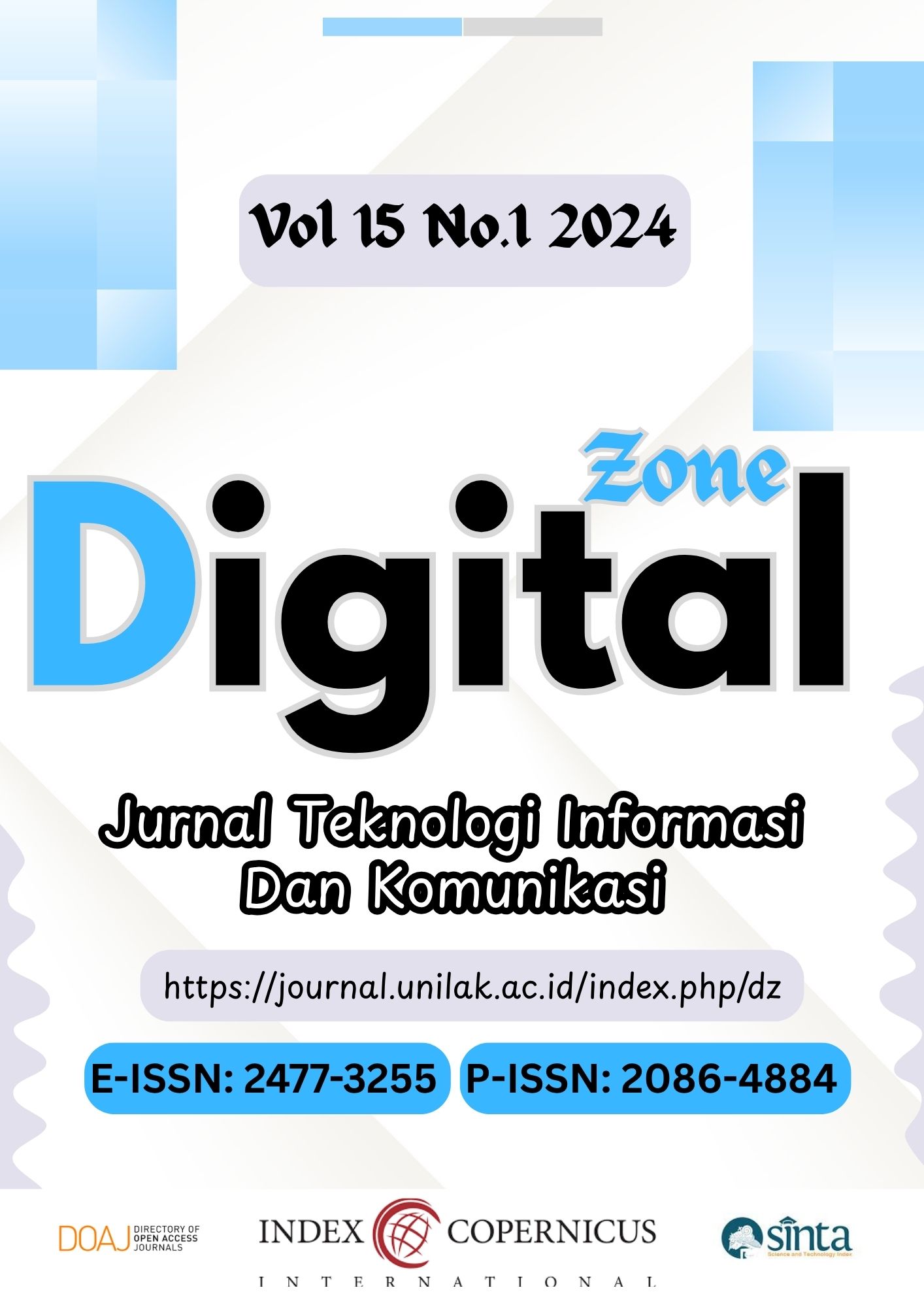Application of the Naïve Bayes Algorithm in Sentiment Analysis of Using the Shopee Application on the Play Store
DOI:
https://doi.org/10.31849/digitalzone.v15i1.19828Keywords:
Sentiment Analysis, Naive Bayes Algorithm, Shopee, Play Store, User ReviewsAbstract
This research aims to find out the opinions of users of the Shopee application on the Play Store using the Naive Bayes Naive Algorithm and to find out the suitability of the correct application of the Naive Bayes algorithm in carrying out sentiment analysis with the classification of three sentiment classes. The dataset used in this study consisted of 2000 customer reviews obtained from the Play Store in 2024 collected by the scraping process using the Python library. The dataset has 1,198 examples of negative attitudes, 583 examples of good sentiment, and 219 examples of neutral sentiment. The results of this study are expected to be used as evaluation material for Shopee Apilkation to improve the performance of Shopee applications. Research findings show that the Bayes naive approach reaches accuracy determined by various aspects, such as the quantity of data collections and positive and negative data distribution. This study shows that the Bayes naive algorithm can function properly as a technique to evaluate user sentiment for applications in the Play Store. However, with the classification of three classes, another algorithm is needed to produce higher accuracy.
References
I. S. K. Idris, Y. A. Mustofa, and I. A. Salihi, “Analisis Sentimen Terhadap Penggunaan Aplikasi Shopee Mengunakan Algoritma Support Vector Machine (SVM),” Jambura J. Electr. Electron. Eng., vol. 5, no. 1, pp. 32–35, 2023, doi: 10.37905/jjeee.v5i1.16830.
N. Agustina, D. H. Citra, W. Purnama, C. Nisa, and A. R. Kurnia, “Implementasi Algoritma Naive Bayes untuk Analisis Sentimen Ulasan Shopee pada Google Play Store,” MALCOM Indones. J. Mach. Learn. Comput. Sci., vol. 2, no. 1, pp. 47–54, 2022, doi: 10.57152/malcom.v2i1.195.
A. Fauzi et al., Metodologi Penelitian, I. Purwokerto: CV Pena Persada, 2022.
M. S. Hasibuan, Suhardi, and T. A. B. Sembiring, “Analisis Sentimen Kebijakan Vaksin Covid-19 Menggunakan SVM dan C4.5,” Universitas Islam Negeri Sumatera Utara, 2021. [Online]. Available: http://repository.uinsu.ac.id/18678/1/Laporan Akhir Penelitian B5 TTD.pdf
Samsir, Ambiyar, U. Verawardana, F. Edi, and R. Watrianthos, “Analisis Sentimen Pembelajaran Daring Pada Twitter di Masa Pandemi COVID-19 Menggunakan Metode Naive Bayes,” J. Media Inform. Budidarma, vol. 5, no. 1, pp. 157–163, 2021, doi: 10.30865/mib.v5i1.2604.
Y. Julianto, D. H. Setiabudi, and S. Rostianingsih, “Analisis Sentimen Ulasan Restoran Menggunakan Metode Support Vector Machine,” J. Infra, vol. 10, no. 1, pp. 1–7, 2022.
M. P. R. Putra and K. R. N. Wardani, “Penerapan Text Mining Dalam Menganalisis Kepribadian Pengguna Media Sosial,” JUTIM (Jurnal Tek. Inform. Musirawas), vol. 5, no. 1, pp. 63–71, 2020, doi: 10.32767/jutim.v5i1.791.
O. I. Gifari, M. Adha, F. Freddy, and F. F. S. Durrand, “Analisis Sentimen Review Film Menggunakan TF-IDF dan Support Vector Machine,” J. Inf. Technol., vol. 2, no. 1, pp. 36–40, 2022, doi: 10.46229/jifotech.v2i1.330.
Farhan, Triase, and A. M. Harahap, “Penggunaan Algoritma Naive Bayes Dalam Text Mining Untuk Klasifikasi Pasal UU ITE,” J. Teknol. Sist. Inf. dan Sist. Komput. TGD, vol. 6, pp. 314–322, 2023.
N. Faridhotul Hidayah, K. Paranita Kartika R., and S. Nur Budiman, “Penerapan Metode Naive Bayes Dalam Analisis Sentimen Aplikasi Sentuh Tanahku Pada Google Play,” JATI (Jurnal Mhs. Tek. Inform., vol. 6, no. 2, pp. 679–683, 2022, doi: 10.36040/jati.v6i2.5610.
H. Setiawan and I. Zufria, “Analisis Sentimen Pembatalan Indonesia Sebagai Tuan Rumah Piala Dunia FIFA U-20 Menggunakan Naïve Bayes,” J. Media Inform. Budidarma, vol. 7, no. 3, pp. 1003–1012, 2023,
F. A. Larasati, D. E. Ratnawati, and B. T. Hanggara, “Analisis Sentimen Ulasan Aplikasi Dana dengan Metode Random Forest,” J. Pengemb. Teknol. Inf. dan Ilmu Komput., vol. 6, no. 9, pp. 4305–4313, 2022, [Online]. Available: http://j-ptiik.ub.ac.id
S. Khairunnisa, A. Adiwijaya, and S. Al Faraby, “Pengaruh Text Preprocessing terhadap Analisis Sentimen Komentar Masyarakat pada Media Sosial Twitter (Studi Kasus Pandemi COVID-19),” J. Media Inform. Budidarma, vol. 5, no. 2, p. 406, 2021, doi: 10.30865/mib.v5i2.2835.
M. Furqan, S. Sriani, and S. M. Sari, “Analisis Sentimen Menggunakan K-Nearest Neighbor Terhadap New Normal Masa Covid-19 Di Indonesia,” Techno.Com, vol. 21, no. 1, pp. 51–60, 2022, doi: 10.33633/tc.v21i1.5446.
D. Duei Putri, G. F. Nama, and W. E. Sulistiono, “Analisis Sentimen Kinerja Dewan Perwakilan Rakyat (DPR) Pada Twitter Menggunakan Metode Naive Bayes Classifier,” J. Inform. dan Tek. Elektro Terap., vol. 10, no. 1, pp. 34–40, 2022, doi: 10.23960/jitet.v10i1.2262.
K. D. Indarwati and H. Februariyanti, “Analisis Sentimen Terhadap Kualitas Pelayanan Aplikasi Gojek Menggunakan Metode Naive Bayes Classifier,” JATISI (Jurnal Tek. Inform. dan Sist. Informasi), vol. 10, no. 1, 2023, doi: 10.35957/jatisi.v10i1.2643.
P. P. O. Mahawardana, I. A. P. F. Imawati, and I. W. Dika, “Analisis Sentimen Berdasarkan Opini dari Media Sosial Twitter terhadap ‘Figure Pemimpin’ Menggunakan Python,” J. Manaj. dan Teknol. Inf., vol. 12, no. 2, pp. 50–56, 2022, [Online]. Available: https://ojs.mahadewa.ac.id/index.php/jmti/article/view/2111http://dx.doi.org/10.24843/JTRTI.2022.v03.i01.p17









